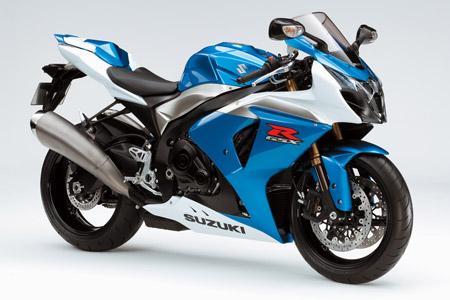American Suzuki introduced the lighter, more compact, more powerful and more agile 2009 GSX-R1000 at its annual dealer show Monday night in Las Vegas, Nevada. The machine’s new liquid-cooled Inline Four engine is a “clean-sheet design.” It has new forged aluminum-alloy pistons with a larger bore of 74.5mm, compared with 73.4mm in the previous model. The stroke is now shorter, 57.3mm versus 59.0mm, resulting in a more over-square arrangement and “better overall tuning potential” for the 999cc powerplant, according to Suzuki. Compression is also greater at 12.8:1 versus 12.5:1. The larger bore provides room for larger titanium valves, 31mm intakes and 25mm exhausts compared with 30mm intakes and 24mm exhausts in last year’s machine. Each valve gets double valve springs made from a new steel alloy. The valves are still actuated by chain-driven dual overhead camshafts, but the intake cam is now shorter and lighter. The intake manifolds are 10mm shorter than before to enhance intake efficiency and power output at high rpm. The cylinders are fed by double-barrel Suzuki Dual Throttle Valve (SDTV) throttle bodies. Each throttle body barrel is equipped with two butterfly valves, one controlled by the rider’s throttle hand and one controlled by the Engine Control Module (ECM) based on throttle position, engine rpm and gear position to maximize intake charge velocity, improve throttle response and enhance low-to-midrange performance. Each throttle body barrel is also equipped with two, 12-hole-nozzle fuel injectors. The primary injector operates under all conditions and is angled down toward the intake ports. The secondary injector is pointed at the secondary butterfly valve and operates only under high-rpm, high load situations. Hotter iridium-tipped spark plugs ignite the air-fuel mixture. The cylinders are now cast as one piece with the upper portion of the crankcases. The cylinders are also plated with a nickel-phosphorus-silicon-carbide bore coating labeled Suzuki Composite Electrochemical Material (SCEM). SCEM is said to reduce friction and improve hear transfer, durability and ring seal. The forged steel alloy crankshaft has been pushed forward in the cases (relative to the cylinder centerline) and the input and output shafts of the close-ratio six-speed transmission have been stacked, resulting in the crankshaft and countershaft being 59.6mm closer together and the overall length of the engine, front-to-rear, being significantly short. Having a two-piece crankcase versus a three-piece design eliminates 16 screws and saves 670 grams of weight. A lighter cable-actuated slipper clutch replaces the previous hydraulic unit, and a new integrated clutch and starter motor cover is 200 grams lighter. The counter balance shaft located in front of the engine is now 20mm in diameter instead of 23mm, reducing mechanical losses. The more compact engine has made room for a shorter main frame, longer swingarm and a shorter wheelbase. The aluminum-alloy, twin-spar main frame is made with five large pieces (a steering head section, two main spars/swingarm pivot locators and cross braces above and below the swingarm pivot) and is shorter from the steering head to the swingarm pivot. The three-piece, aluminum-alloy swingarm has an arched shape to allow the dual mufflers to tuck in better and is 33mm longer to enhance rear tire traction. The wheelbase is now 10mm shorter (55.3 inches/1405mm) for more nimble cornering. Rake is 23.8 degrees with 3.9 inches (98.3mm) of trail. A new, bolt-on, one-piece, die-cast, aluminum-alloy rear subframe is lighter. Suzuki claims the new GSX-R1000 is 5 kg lighter and weighs 448 pounds (203 kg) wet. The new bike also gets new suspension from Showa. The rear shock is four-way adjustable and works via a new aluminum-alloy linkage. Like previous versions, the new GSX-R1000 comes with an electronically-controlled steering damper that increases its damping effect as speeds increase. The big news in the suspension department is the forks, which are Showa’s new Big Piston Fork (BPF) design, the same design used on the GSX-R1000 that won the 2007 Suzuka 8 Hours endurance race. Rather than placing a cartridge mechanism inside of each fork leg, Showa has simply lined the inner walls of the 43mm BPF fork tubes and fitted a larger-diameter (39.6mm) piston. This design eliminates parts, saves weight (720 grams), provides better feedback, has better compression damping qualities and with the springs located at the bottom of each fork leg instead of the top makes servicing the forks much easier. Rebound and compression damping adjusters are located on the fork cap of each leg, while preload is adjustable at the bottom of each leg. The front braking system on the 2009 GSX-R1000 includes dual 310mm rotors mounted on lighter new carriers. Each rotor is grabbed by a forged aluminum-alloy monoblock Tokico caliper that is not only more rigid but 205 grams lighter for a total savings of 410 grams. Each caliper has pistons with staggered sizes, 30mm/32mm instead of the previous calipers’ 30mm/34mm. To improve feedback the radial master cylinder diameter has been downsized from 19mm to 17mm. Aluminum-alloy wheels are lighter but still measure 3.50 x 17.0 inches front and 6.00 x 17.0 inches rear. They will come shod with 120/70-ZR17 and 190/50-ZR17 Bridgestone BT016 Battlax radials, respectively. The new machine is wrapped in new bodywork. The upper fairing locates the louvered intakes for the Suzuki Ram Air-Direct (SRAD) system closer to the high-pressure center of the nose. The headlight stacks the high- and low-beams between a pair of running lights. The upper fairing is also wider to provide better wind protection for the rider’s upper body and hands, while a new trapezoidal-shape (instead of rectangular) oil cooler allows for a narrower and more aerodynamic lower fairing. The fuel tank gets a new shape but still holds 17.5 liters of fuel. A cover to replace the passenger seat comes with each bike. The rearsets are still three-position adjustable to suit rider preference. The bike gets new instrument cluster, and the three-setting Suzuki Drive Mode Selector (S-DMS) selector switch has been moved from the right handlebar to the left. The Suzuki Advanced Exhaust System (SAES) exhaust system incorporates staggered-length titanium header pipes, a collector, a short mid-pipe (where the torque-enhancing, noise-abating, ECM-controlled Suzuki Exhaust Tuning (SET) butterfly valve and fuel-injection system’s oxygen sensor are located), a stainless steel under-engine exhaust chamber and two titanium mufflers. Suzuki’s Pulsed AIR (PAIR) system is still used to ignite unburned fuel in the exhaust ports to clean up emissions. The manufacturer suggested retail price of the new GSX-R1000 is $12,199, and it will be available in March 2009.
Suzuki Introduces Lighter, More Compact, More Agile, More Powerful GSX-R1000 To Its Dealers In Las Vegas
Suzuki Introduces Lighter, More Compact, More Agile, More Powerful GSX-R1000 To Its Dealers In Las Vegas
© 2008, Roadracing World Publishing, Inc.






